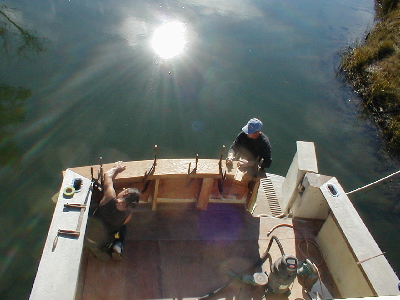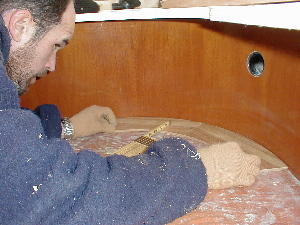Restoration
December 10, 2003
herokee took her second ocean run Sunday, reaching Cape Lookout from Gloucester in 15 minutes (Cherokee was able to get within five feet of the lighthouse shore!) and then out around the hook. Her top speed this time was 37.8 knots. Seas were moderate and she handled well. Now that the engines have been aligned and one new turbo and injector installed, mechanical work gives way to the finishing of the cockpit. Below, Bryan and Leonard are installing the remains of the teak covering board that caps the transom and swim platform door.

Bryan, Leonard, and the Sun Working on the Teak Transom Cap


Tricky Hinge Area, Clamping the Teak
After patterns were made of luan plywood, the teak covering boards were cut and glued in place. Below the guys work that last piece at the swim door joint before some unsettled December weather rolls in.

The Last Piece
Sharon Hunt and her brand new daughter-in-law Carolyn Brice have joined the crew to varnish everything else on the boat, and to keep up with maintenance varnishing. Below left they tackle the hallway wainscotting. Below right, Chris Hunt (no relation to Sharon) is fitting the pieces of the teak border under the settee in the galley. Next the teak and holly plywood will be positioned. The border will be set on top, and the plywood scribed and cut before glueing.


The Varnish Vixens and Chris

Tom Parker Standing Tall in Galley
Above, Tom Parker is building the last set of galley cabinets to house the microwave oven, a variety of cookware, and two computers (one for navigation and one for DVDs, CDs, Internet, Solitaire, etc.). Tom also cut the counter, which will be covered in a white Swanstone composite. Leonard is fabricating pieces for the flybridge console. Below, he’s guaging the diameter of the round corners for a forward-facing, two-person seat attached to the console.

Leonard Working on a Flybridge Two-Seater
There are no prescription drug benefits for the fish, frogs, and alligators that are increasingly exposed to a variety of chemicals we pharmaceutical-happy Americans take and eventually flush down the toilet and into rivers and sounds! “Will you look into the impact of estrogen on the marine environment?” asked a Dare County resident to the North Carolina Marine Fisheries Commission. There has been much publicity of “estrogen mimics” – chemicals from pesticides and herbicides that damage fish, frog, and alligator endrocrine systems. But recently scientists have linked estrogen from contraceptives to altered sex organs of juvenile fish and declining fertility rates of adult fish. And if you’ve noticed that fish don’t fight quite as hard as they used to, and are in fact relaxed at the end of your line, it might be related to what a Texas scientist just found – traces of Prozac in the brains, livers, and muscles of bluegill caught downstream from a water treatment plant! How can we reverse this trend? One way is to develop some kind of ultra-filtration system for water and sewerage treatment plants. Another way is to take a hard look at what a drug-dependent society we’ve become – it’s bleeding over into the natural world and giving us lethargic, sexually dysfunctional fish that are hot-flash free and unable to just say no. Signing off for now, Barbara “Fish Doctor” Blake








